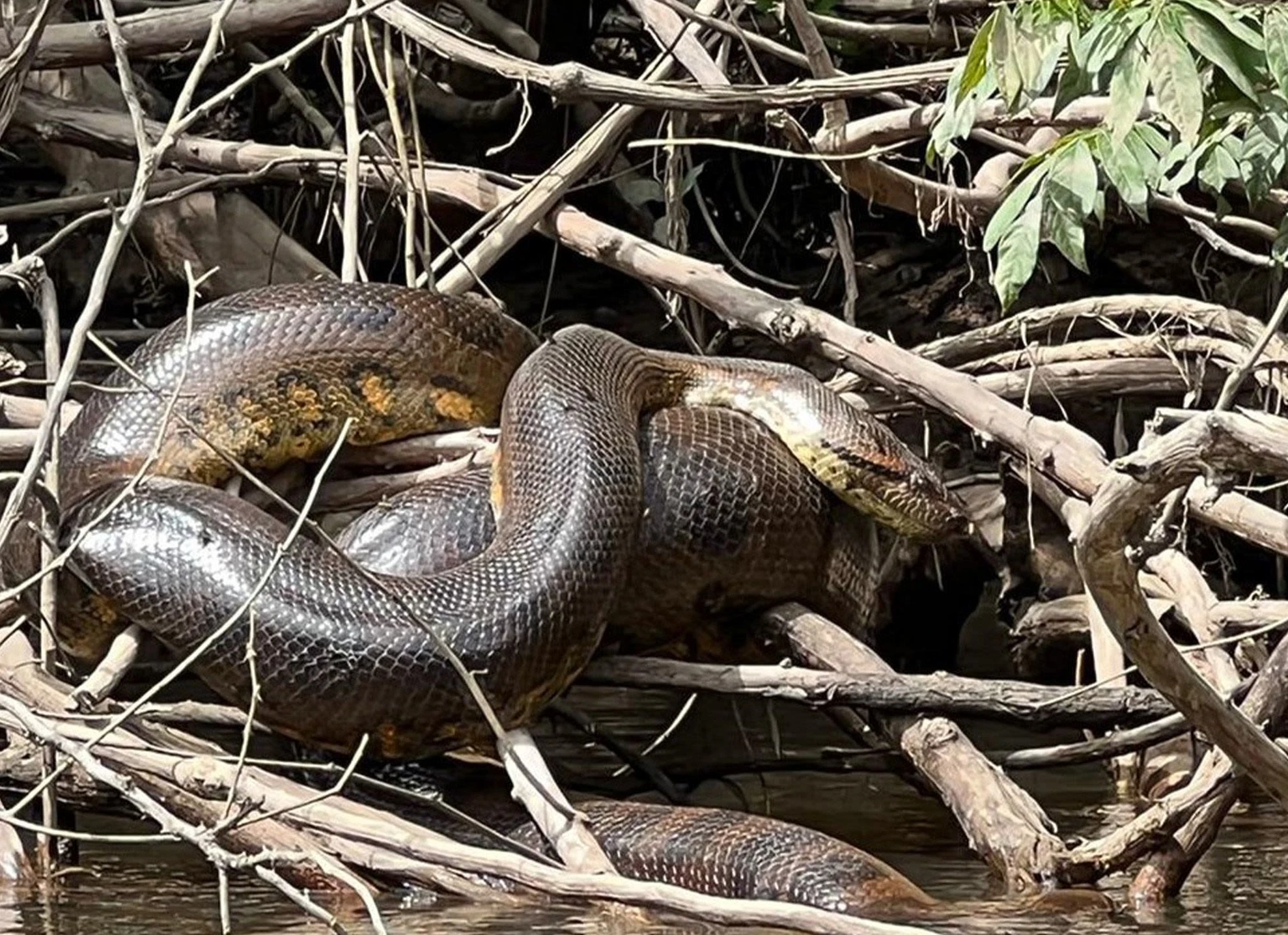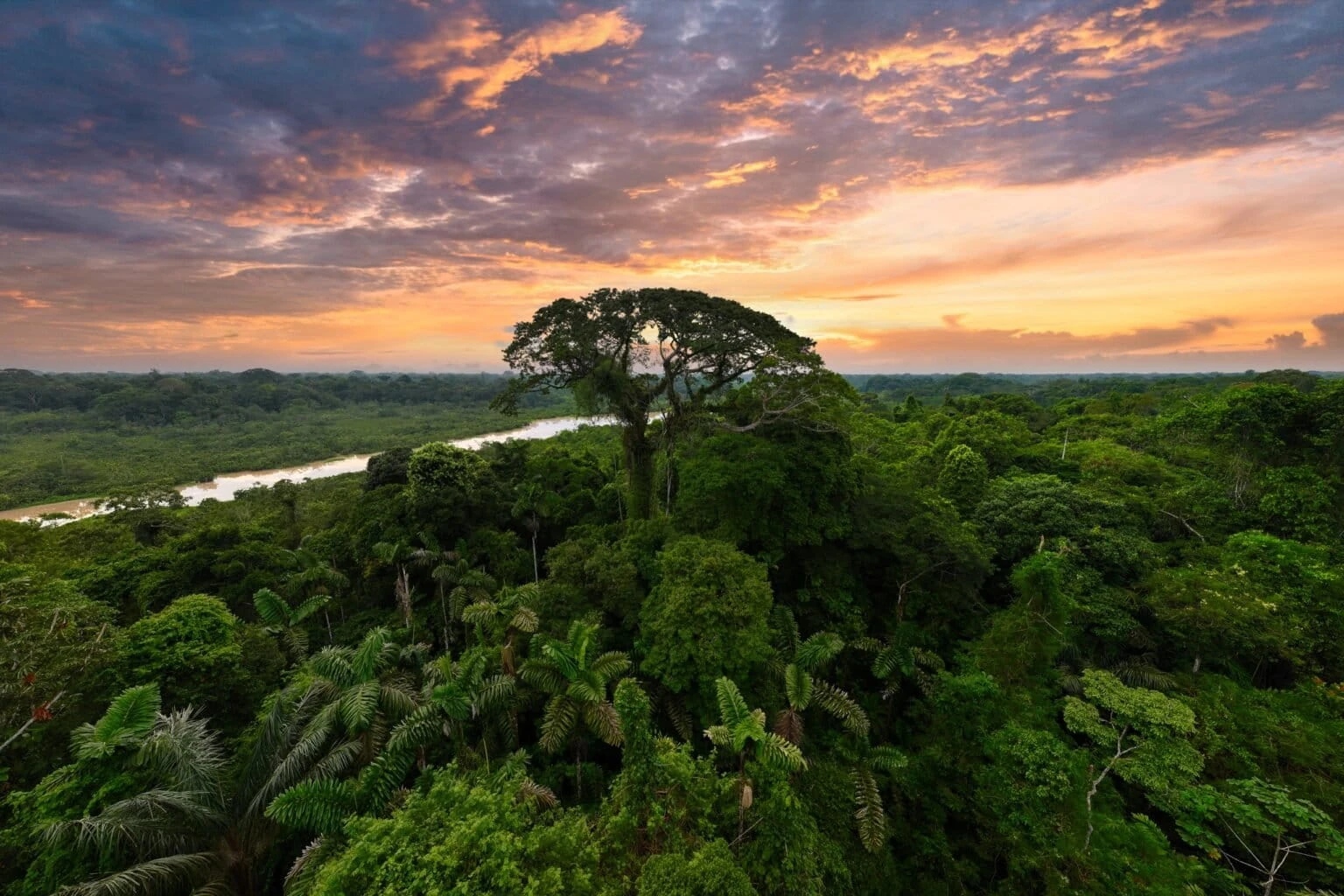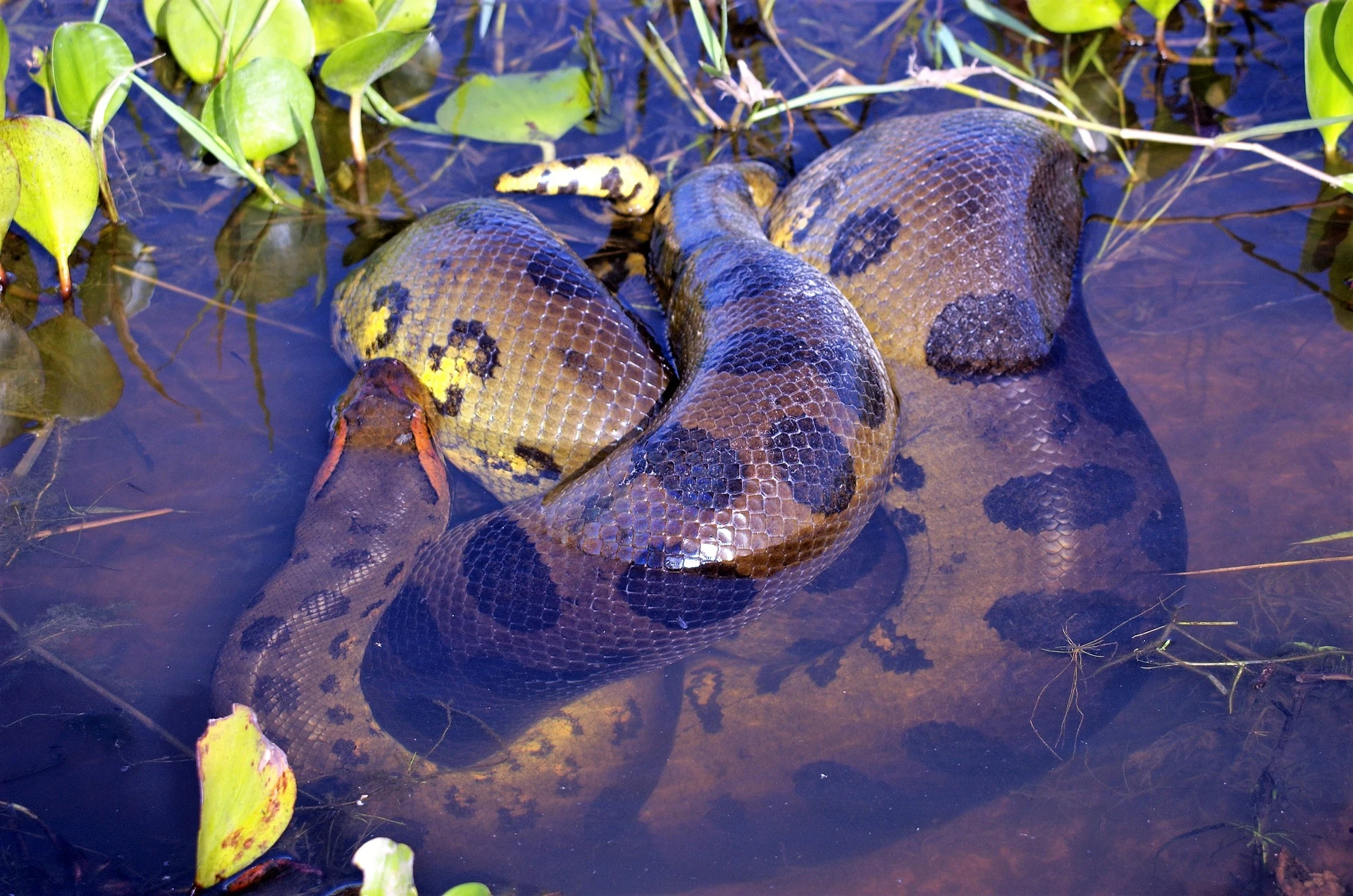The Amazon Rainforest is a land of extraordinary biodiversity, home to countless species of flora and fauna. Among its most fascinating inhabitants is the formidable anaconda a giant serpent that stirs both fear and curiosity.
The anaconda is one of the largest snakes in the world, known for its impressive size and strength. Found primarily in the Amazon basin, these snakes are semi-aquatic, thriving in the swamps and marshes of the rainforest. Their elusive nature makes them a rare sight, but with the right approach and guidance, encountering an anaconda in the wild can be an unforgettable experience.
Anaconda Species

Anacondas spend much of their time in water, where their powerful bodies are perfectly adapted for swimming. Their eyes and nostrils are positioned on top of their heads, allowing them to breathe and observe their surroundings while remaining mostly submerged. This adaptation helps them remain stealthy while hunting, as they can wait for prey to come close without revealing their presence.
These snakes are ambush predators, relying on stealth and patience to capture prey. They feed on a variety of animals, including fish, birds, and mammals. Unlike venomous snakes, anacondas constrict their prey, using their muscular bodies to suffocate their victims before consuming them whole. This method of hunting requires immense strength and precision, showcasing the anaconda’s prowess as a top predator.
Anaconda’s Habitat in the Amazon
The Amazon basin provides an ideal habitat for the anaconda, with its vast network of rivers, swamps, and marshes. The dense vegetation and abundant water sources support a rich ecosystem, offering ample hunting opportunities for these snakes. This environment also provides cover, making it easier for anacondas to ambush unsuspecting prey. Understanding the anaconda’s habitat is key to appreciating its role in the Amazon’s complex ecological web.
Anacondas play a crucial role in maintaining the balance of the Amazon ecosystem. As apex predators, they help regulate the populations of various prey species, preventing any one group from becoming too dominant. This regulation is essential for preserving the biodiversity of the rainforest and ensuring the health of its habitats.
Anaconda Behavior and Interaction with Prey
In addition to controlling prey populations, anacondas also serve as prey for other animals when young. Birds of prey and larger carnivores may target juvenile anacondas, contributing to the intricate food web of the Amazon. This dynamic interaction between predator and prey highlights the interconnectedness of life in the rainforest, with each species playing a vital part.
The presence of anacondas also influences the behavior of other animals in the ecosystem. Prey species have evolved various strategies to avoid detection, such as camouflage and altered activity patterns. These adaptations demonstrate the evolutionary pressure exerted by predators like the anaconda, underscoring their importance in shaping the Amazon’s diverse wildlife.
Cultural Significance of Anacondas
The anaconda holds a significant place in the folklore and culture of the Amazon’s indigenous peoples. Many tribes regard the anaconda as a powerful spiritual symbol, embodying strength, resilience, and mystery. Stories and myths often depict the anaconda as a guardian of the waters, reflecting its close association with the region’s rivers and swamps.
These cultural narratives highlight the deep connection between the anaconda and the people of the Amazon. By understanding the cultural significance of the anaconda, we gain insight into the values and beliefs of the indigenous communities that have coexisted with these snakes for generations. This connection also emphasizes the importance of preserving the Amazon’s natural and cultural heritage.
The portrayal of anacondas in popular media often fuels misconceptions about their nature. While these snakes can be formidable, they are not mindless killers. Anacondas play a vital ecological role and are typically wary of humans. Educating the public about the true nature of anacondas can help dispel myths and promote Amazon conservation efforts.
Wildlife Encounters in the Amazon
A journey to the Amazon offers more than just the chance to see anacondas. The rainforest is teeming with life, from the vibrant macaws that soar overhead to the playful otters that frolic in the waterways. Each encounter adds a new layer of wonder to your adventure, showcasing the incredible diversity of this unique ecosystem.
Macaws: The Vibrant Aviators
The Amazon is a birdwatcher’s paradise, and macaws are among its most spectacular residents. These colorful parrots are often seen in pairs or flocks, their vibrant plumage lighting up the canopy. Listen for their raucous calls as you traverse the jungle trails. Observing Parrots in flight is a mesmerizing experience, as their bright colors contrast sharply with the lush greenery of the forest.
Sloths: Masters of Camouflage
For those with a keen eye, sloths may be spotted lazily hanging from the branches of the forest. These slow-moving mammals are masters of camouflage, blending seamlessly with the foliage. Their unhurried pace and tranquil demeanor make them fascinating subjects for observation, offering a glimpse into a lifestyle perfectly adapted to the rainforest environment.
Sloths have a unique relationship with the ecosystem, as their fur provides a habitat for algae and insects. This mutualistic relationship benefits both the sloth and its passengers, illustrating the complex interdependencies that characterize the Amazon’s wildlife. Spotting a sloth is not only a delight but also an opportunity to appreciate the intricate web of life in the rainforest.
Beyond macaws and sloths, the Amazon is home to an astonishing array of wildlife. Monkeys swing through the treetops, while jaguars prowl the forest floor. The waterways teem with life, from caimans lurking beneath the surface to pink river dolphins playing in the currents. Each species contributes to the rich tapestry of biodiversity that defines the Amazon.
Echological Richness
The sheer variety of animals in the Amazon is a testament to the region’s ecological richness. Each species plays a specific role in the ecosystem, contributing to its stability and resilience. Understanding the interactions between these animals deepens our appreciation for the complexity of the rainforest and underscores the importance of its conservation.
The Amazon’s wildlife also holds immense scientific value, offering insights into evolutionary processes and ecological dynamics. Researchers continue to discover new species and uncover fascinating behaviors, highlighting the rainforest’s status as a living laboratory. This ongoing exploration fuels our curiosity and drives efforts to protect this invaluable natural resource.
Exploring Manu and Tambopata National Reserves

The Manu and Tambopata National Reserves are prime destinations for wildlife enthusiasts. Rich in biodiversity, these protected areas offer guided tours and excursions that bring you up close to the rainforest’s inhabitants. Whether you’re navigating the waterways in search of capybaras or trekking through the jungle on the lookout for elusive wildlife, these reserves provide unparalleled opportunities for adventure and discovery.
Manu National Park is renowned for its diverse habitats, ranging from lowland rainforests to cloud forests. This diversity supports a wide array of species, making it a hotspot for wildlife encounters. Visitors can embark on guided treks, canoe trips, and birdwatching Manu expeditions, each offering a unique perspective on the park’s natural wonders.
Tambopata National Reserve is celebrated for its vibrant ecosystems and cultural heritage. The reserve’s lodges and research stations provide comfortable bases for exploring the surrounding wilderness. Guided tours offer insights into the area’s rich biodiversity, cultural history, and conservation efforts, creating a comprehensive and immersive experience.
Tips for a Successful Amazon Trip
Both reserves play a critical role in conservation efforts, protecting vital habitats and supporting research initiatives. By visiting these areas, travelers contribute to the preservation of the Amazon’s unique ecosystems and support sustainable tourism practices that benefit local communities and wildlife alike.
Photography in the Amazon
For freelance photographers, the Amazon presents an abundance of picturesque scenes and cultural nuances. The interplay of light and shadow in the dense forest, the vibrant hues of the wildlife, and the raw beauty of the landscape provide endless inspiration for capturing stunning images. Each photograph tells a story, inviting viewers to experience the magic of the rainforest through the lens.
To enhance your storytelling through photography, consider learning about the cultural significance of the wildlife and the ecosystems they inhabit. Understanding the role of these creatures in the local culture can add depth and meaning to your images, allowing you to convey a richer narrative. This knowledge enriches your photographic journey, enabling you to create visuals that resonate with authenticity and emotion.
The Amazon’s unique lighting conditions offer both challenges and opportunities for photographers. The dappled sunlight filtering through the canopy creates dramatic contrasts, while the soft, diffused light of overcast days enhances the colors of the flora and fauna . Mastering these conditions can elevate your photography, resulting in images that capture the essence of the rainforest.
Best Time to Visit

When planning a trip to the Amazon, preparation is key. Here are some tips to help you make the most of your journey:
The Amazon experiences a tropical climate with high humidity and rainfall throughout the year. The dry season, from June to November, is generally considered the best time to visit, as water levels are lower, making wildlife easier to spot. During this period, trails are more accessible, and the reduced vegetation density improves visibility, enhancing your chances of encountering diverse wildlife.
Visiting during the wet season, from December to May, offers a different perspective on the Amazon. The rainforest comes alive with lush greenery, and the swollen rivers create opportunities for unique boat excursions. While wildlife may be harder to spot, the vibrant landscapes and dramatic weather patterns provide a captivating backdrop for exploration.
Regardless of the season, being prepared for the Amazon’s unpredictable weather is essential. Rain showers can occur at any time, so having appropriate rain gear and waterproof bags for your equipment is advisable. Embracing the rainforest’s dynamic climate adds an element of adventure to your journey, allowing you to experience its many moods.
Packing List
Bring lightweight, breathable clothing to stay comfortable in the humid conditions. Long sleeves and pants are recommended to protect against insects. Don’t forget essentials like a wide-brimmed hat, sunscreen, and insect repellent. A good pair of binoculars will enhance your wildlife-viewing experience, and a waterproof bag will protect your gear during boat excursions.
Proper footwear is crucial for navigating the rainforest’s varied terrain. Sturdy, waterproof hiking boots are ideal for trekking through muddy trails and crossing streams. Additionally, packing a reliable flashlight and extra batteries is advisable for nighttime excursions, as the Amazon’s nocturnal wildlife offers its own unique encounters.
Consider including a reusable water bottle and portable water purifier in your packing list. Staying hydrated is vital in the Amazon’s humid climate, and having a sustainable solution for clean water reduces your environmental impact. This eco-friendly approach aligns with the principles of responsible travel, supporting the preservation of the rainforest.
Guided Tours
Hiring a local guide can greatly enhance your Amazon experience. Knowledgeable guides provide insights into the rainforest’s ecology and help you navigate its complex terrain. They can increase your chances of spotting elusive wildlife and offer cultural context that enriches your understanding of the region.
Local guides are invaluable sources of information, sharing stories and traditions passed down through generations. Their expertise extends beyond wildlife identification, encompassing the cultural, historical, and ecological aspects of the Amazon. Engaging with local guides fosters a deeper appreciation for the rainforest and promotes sustainable tourism practices.
Participating in guided tours in Manu also supports the local economy, providing livelihoods for indigenous communities and conservation initiatives. By choosing responsible jungle tours operators, travelers contribute to the preservation of the Amazon’s natural and cultural heritage. This collaborative approach ensures that future generations can continue to experience the wonders of the rainforest.
Encouragement to Explore and Protect the Amazon

The Amazon Rainforest is a realm of wonder and mystery, where the mighty anaconda reigns as one of its most iconic inhabitants. From the breathtaking beauty of the landscape to the diverse array of wildlife, a journey into this lush wilderness promises unforgettable encounters and lasting memories.
Whether you’re a corporate executive seeking a well-organized itinerary, a freelance photographer in pursuit of the perfect shot, or an academic researcher looking for comprehensive insights, Amazon offers something for everyone. With careful planning and an adventurous spirit, you can embark on a transformative journey that connects you with the natural world in profound ways.
So, what are you waiting for? Start planning your adventure to the Amazon Rainforest and discover the giant snake and its incredible ecosystem for yourself. Embrace the opportunity to witness the majesty of the anaconda and the vibrant life that flourishes in this extraordinary environment. Let the Amazon inspire your curiosity, fuel your passion for exploration, and deepen your connection to the wonders of the natural world.




